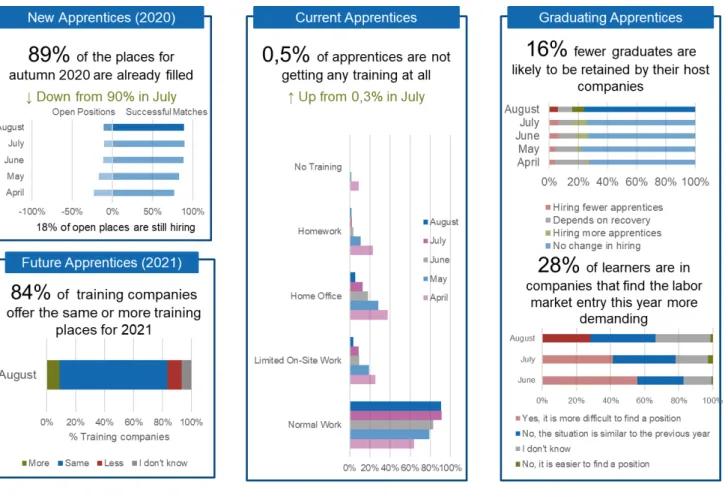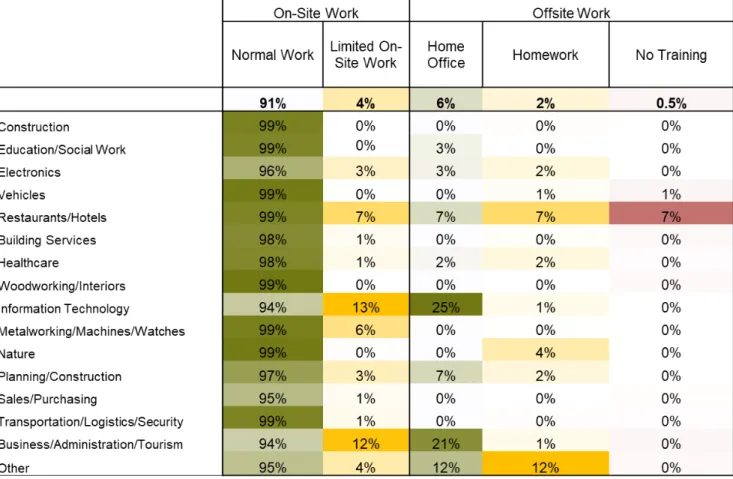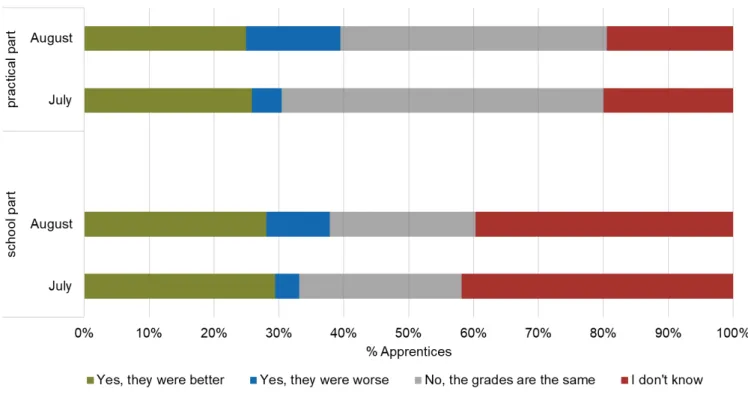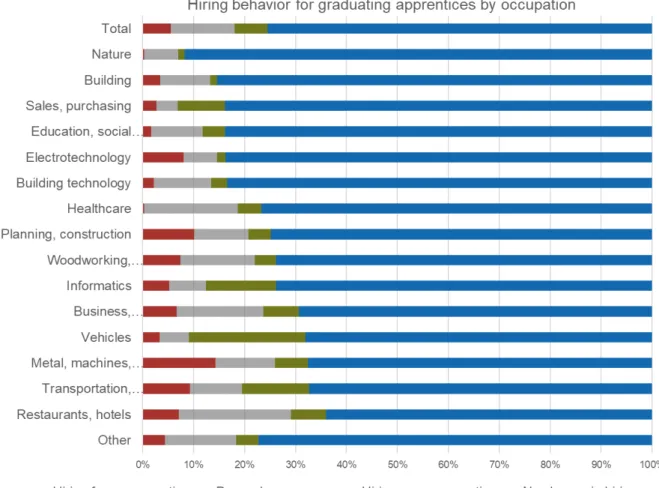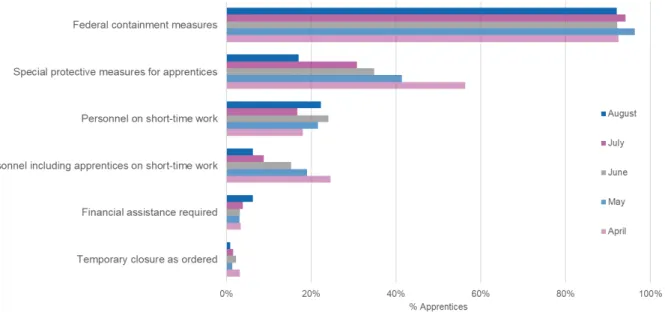Research Collection
Other Publication
Apprenticeship Pulse Results August 2020
Author(s):
Bolli, Thomas; Caves, Katherine M.; Pusterla, Filippo; Rageth, Ladina; Renold, Ursula; Sritharan, Aranya;
Trachsel Díaz-Tejeiro, Sandra Publication Date:
2020-09-03 Permanent Link:
https://doi.org/10.3929/ethz-b-000440239
Rights / License:
In Copyright - Non-Commercial Use Permitted
This page was generated automatically upon download from the ETH Zurich Research Collection. For more information please consult the Terms of use.
ETH Library
Apprenticeship Pulse – Factsheet
Apprenticeship Pulse Results
August 2020
3. September 2020 Research Team
Thomas Bolli, Katherine M. Caves, Filippo Pusterla, Ladina Rageth, Ursula Renold, Aranya Sritharan, Sandra Trachsel Díaz-Tejeiro Chair of Education Systems, ETH Zürich, Switzerland
Research Partners Urs Casty
Domenica Mauch Yousty.ch
Professional.ch Every month, the Apprenticeship Pulse surveys the
impact of the Corona pandemic on apprentices in Switzerland. While Switzerland was still in shutdown in April 2020, the measures taken at that time to contain the pandemic were gradually eased in the following months. Thus, the fifth Apprenticeship Pulse Survey in August 2020 records the impact of the pandemic on apprentices after the previous re- laxation of the prescribed measures.
The month of August marks important changes in the course of an apprenticeship. On the one hand, most apprenticeship contracts expire at the end of July; on the other hand, in most cantons new apprenticeships start at the beginning of August. In addition, the ap- prenticeships will be advertised for 2021. These changes have an impact on the Apprenticeship Pulse Survey. The August survey focuses on the results of the final year classes and thus on the apprentices.
Moreover, we are already looking at the number of ap- prenticeship places available for the start of the ap- prenticeship in the fall of 2021.
This fact sheet provides an overview of the impact of the Corona pandemic on vocational training in August 2020 and compares these results with the situation according to the four previous surveys in April, May, June and July.
The results are presented separately for the three groups of apprentices:
- Group 1: future apprentices
- Group 2: current apprentices who are being trained in the companies affected by the Corona cri- sis
- Group 3: Apprentices who were in their final year of apprenticeship during the shutdown, i.e. who completed their apprenticeship this year and are about to enter the labor market
The Pulse of Apprentices in August 2020 - Main Points
Figure 1: The headlines on Apprenticeship Pulse in August 2020.
Remarks: Results based on data of the Apprenticeship Pulse surveys 04.2020 (April), 05.2020 (May), 06.2020 (June), 7.2020 (July) and 08.2020 (August). The left box shows the main results for future apprentices in 2020 and 2021, the middle box for current apprentices and the right box for graduating apprentices.
In the German-speaking part of Switzerland, young people start the application process one year be- fore they begin their apprenticeship (Group 1).
This means that for apprenticeships starting in sum- mer 2020, the process started in August 2019; for ap- prenticeships starting in summer 2021, it now starts in August 2020. This is why we are able to present figures for the start of apprenticeships in 2021 for the first time with the August survey. But first, let's look at the current year.
Apprenticeships that start in autumn 2020: Due to the economic impact of the Corona pandemic, many feared apprenticeship positions would be lost for the summer of 2020. However, training companies re- ported in August that only 2.1% (2.1% in July, 3.0% in June, 2.6% in May, 2.7% in April) of the apprentice- ship places were cancelled due to the pandemic. Fur- thermore, in August, 0.7% (1.6% in July, 1.8% in June, 2.0% in May, 5.2% in April) of the apprentice- ships are at risk, depending on the course of busi- ness. 89% (90% in July, 88% in June, 83% in May,77% in April) of the apprenticeships offered for
summer/autumn 2020 have already been filled, i.e.
11% (10% in July, 12% in June, 17% in May, 23% in April) are still open and can therefore be filled until au- tumn.
For the start of the apprenticeship in summer 2021, we asked training companies for the first time about their apprenticeship offers. In the process, 84% of the companies report that they offer the same number or even more training places than planned. At the same time, 75% of the training companies will offer the same number of training places as for summer/autumn 2020, 9% will offer more training places, 10% will offer fewer training places and 7% do not know yet. The "Appren- ticeship Pulse" will continue to survey these apprentice- ship offers in the coming months and will show results for specific occupational fields and language regions, if the sample size allows it.
Current apprentices (Group 2) were strongly affected by the emergency measures. Nevertheless, in August 91% (91% in July, 86% in June, 77% in May, 64% in April) of apprentices were able to work by applying the protective measures of the Federal Office of Public
Health of the Swiss Confederation (especially dis- tance and hygiene rules). 4% (9% in July, 10% in June, 17% in May, 25% in April) of the apprentices worked for a limited extent at their workplace and 6%
(13% in July, 19% in June, 26% in May, 37% in April) were at least partially at home. 2% (2% in July, 4% in June, 9% in May, 23% in April) of the apprentices re- ceived homework for their practical training. 0.5%
(0.3% in July, 0.6% in June, 1.3% in May, 9% in April) of the apprentices did not receive any in-company training due to company closures. The August survey shows that the loosening of the rules that has taken place so far has gradually led the vast majority of ap- prentices being able to go back to their jobs. How- ever, the slight increase since July is problematic for apprentices without in-company training.
Apprentices who completed their apprenticeship in summer 2020 (Group 3) will enter the labor mar- ket in August. Usually, some of the apprentices will continue to be employed by their companies after their apprenticeship - but not all of them. 76% (74%
in July, 73% in June, 79% in May, 73% in April) of the apprentices are in companies that have not yet changed their practice of keeping apprentices in employment due to the Corona pandemic. Training companies that retain more apprentices than usual employ 8% (10% in July, 8% in June, 3% in May, 2% in April) of the apprentices. However, 10% (10%
in July, 12% in June, 14% in May, 21% in April) of the apprentices work in training companies where the probability of continuing employment after they finish their apprenticeship has decreased because they still depend on the further course of business.
6% (the same as in July and June, 4% in May and April) of apprentices work in companies that have already decided to keep fewer apprentices after completing the apprenticeship. This means that pos- sibly 16% (same as in July, 18% in May and June, 25% in April) fewer apprentices can remain in the company after they have completed their appren- ticeship.
Detailed Results
Future Apprentices (Group 1)
In total, 89% of apprenticeships for summer 2020 were already filled in August (90% in July, 88% in June, 81% in May, 77% in April). Although in many cases the apprenticeship starts in August, it is possi- ble to start with an apprenticeship in October. This is because the recruiting phase has been extended by the responsible authorities for this year until October.
18% of the training companies make use of this ex- tended recruitment phase. 73% of the training compa- nies do not need it and 9% do not know.
Table 1 shows the measures that training companies are taking to recruit apprentices for the fall. Compared to the previous months, it is noticeable that online inter- views are increasingly used in the recruitment process in August.
April May June July August Online-
Interviews 40% 37% 22% 12% 25%
Personal in-
terviews 21% 50% 60% 48% 45%
Trial
Teachings 26% 47% 63% 48% 56%
Social
Media 17% 21% 18% 8% 11%
Table 1: Methods to recruit apprentices
Results based on data from the Apprenticeship Pulse surveys 04.2020 (April), 05.2020 (May), 06.2020 (June), 07.2020 (July) and 08.2020 (August). The table shows the proportion of training compa- nies per method (multiple answers possible).
Current Apprentices (Group 2)
According to the August survey, only 0.03% (same in July and June, 0.01% in April and May) of the existing apprenticeship contracts for current apprentices were cancelled due to the Corona pandemic. Figure 2 on the following page shows the effects of the pandemic on vocational training in each occupational field. The ef- fects vary according to the occupational field. In most occupational fields, with the exception of "Information Technology" and "Economy/Administration/Tourism", most or almost all of the apprentices were working nor- mally (with protective measures) in August. Only 6%
(13% in July, 19% in June, 26% in May, 37% in April) of apprentices worked in the home office. The occupa- tional fields with the highest percentage of home-office work were of "Information Technology", "Economy/Ad- ministration/Tourism", "Hospitality/Hotel industry" and
"Planning/Construction". In August, there was a slightly higher percentage (0.5%; 0.3% in July, 0.6% in June, 1.3% in May, 9% in April) of training companies whose apprentices did not receive in-company training com- pared to previous months. The occupational field "Gas- tronomy/Hotel Industry" is particularly affected. The percentage of those who received homework remained stable (2%; same in July, 4% in June, 9% in May, 23%
in April).
Figure 2: Effects of the Corona pandemic on the training of apprentices by occupational field.
Comments: Results based on data from the Apprenticeship Pulse survey 08.2020 (August). The table shows for each measure and occu- pational field the shares (%) of apprentices of all apprentices covered by the surveyed training companies in the respective occupational field (multiple answers possible); occupational fields with fewer than 50 training companies are not listed but are summarized under
"Other".
Catching up on the Missed Material
With a score of 4.15 (4.35 in July, 4.24 in June, 4.14 in May, 4.15 in April) out of a maximum of 5 points (5 stands for “everything can be made up”), the training companies are of the opinion that the apprentices can no longer fully catch up on the material they have missed during the remaining apprenticeship pe- riod. The value for the inter-company courses is somewhat more optimistic at 4.16 (4.29 in July) and somewhat more pessimistic at 4.02 (4.09 in July) for school-based training.
Apprenticeship Graduates with Graduation in Summer 2020 (Group 3)
Apprentices in their final year of training faced two challenges due to the Corona crisis: firstly, the qualifi- cation procedures (QV) were adapted and secondly, they faced a difficult transition to the labor market.
Qualification Procedure and Apprenticeship Cer- tificate
In the months from April to June, training companies
stated that the Corona crisis will have a moderate influence on graduating apprentices’ final school grades (mean values of 3.2 in June and 3.4 in April and May on a scale from 1 "has no influence at all" to 5 "has a very strong influence"). The training compa- nies also expected the companies QV to have an in- fluence on the final grade of the apprentice (mean values of 2.8 in June, 2.7 in May and 2.9 in April on a scale from 1 "Has no influence at all" to 5 "Has very strong influence").
In the July and August surveys, we asked for the real results of the QV. 67% (70% in July) of the appren- tices work in training companies where the same number of apprentices have obtained their vocational qualification compared to the previous year. 19%
(17% in July) of the apprentices work in companies where more apprentices have completed their train- ing and 14% (13% in July) work in companies where fewer apprentices have completed their training this year.
The question was also asked whether the grades of the practical part of the qualification procedure (QV)
were different from previous years. As Figure 3 shows, 25% (26% in July) of the apprentices work in training companies that reported that their apprentice- ship graduates achieved better grades this year, 14%
(5% in July) in companies that reported that their grades were worse and 41% (50% in July) in compa- nies that observed grades comparable to those of the previous year. 20% (July and August) of the appren- tices work in companies that do not know. Regarding
the school-based part of the QV, 28% (29% in July) of the apprentices are employed in training compa- nies that observed better marks than in the previous year; 10% (4% in July) in companies where the marks were worse and 22% (25% in July) in compa- nies where the marks were comparable to the previ- ous year. 40% (42% in July) are in training
companies that do not know.
Figure 3: Final grades for the practical and school part
Remarks: Results based on data from the Apprenticeship Pulse Surveys July and August 2020. The chart shows the percentage of ap- prentices per month and type of qualification procedure (QV) out of all apprentices covered by the interviewed training companies.
Continued Employment Practice
In August, 76% (74% in July, 73% in June, 79% in May, 73% in April) of the apprentices worked in com- panies that had not yet changed their practice of re- taining trainees after they had completed their
training. As Figure 4 on the following page shows, not all occupational fields are affected in the same way.
Uncertainty regarding continued employment is still greatest in the occupational fields of "Food" (21% in August, 23% in July, n.a. in May and June) and
"Health" (18% in August, 22% in July, 25% in June, 34% in May) followed by the occupational fields of
"Hospitality/Hotel Industry" (22% in August, 21% in July, 25% in June, 29% in May). In most occupational fields, fewer apprenticeship graduates are still em- ployed. This applies in particular to "Metal/Ma-
chines/Watches" (14% in August, 12% in July, 11% in June, 9% in May). In the occupational field "Nature"
(92% in August and July, 93% in June, 87% in May), the practice of continuing employment is the most stable compared to previous practice.
Figure 4: Continuation of employment after completing the apprenticeship by occupational field.
Remarks: Results based on data from the Apprenticeship Pulse surveys April to August 2020 (aggregated data over all five months).
The chart shows the share of apprentices out of all apprentices covered by the surveyed training companies for each possible practice of continuing employment and for each occupational field.
Figure 5 presents the challenges that young profes- sionals face when entering the labor market. It shows the answers of the training companies to the question: «Compared to last year, is it currently more difficult for your apprentices to find a job after gradu- ation?».
Figure 5: Challenges at the start of a career.
Comments: Results based on data from the Apprenticeship Pulse surveys 06.2020 (June), 07.2020 (July) and 08.2020 (August). The chart shows possible challenges when entering the labor market based on the share of apprentices out of all apprentices covered by the surveyed training companies.
Compared to the assessment in June, the situation has eased further. 28% (41% in July, 56% in June) of apprentices are in companies that offer appren- ticeships claim it will be more
difficult this year for apprentices to find a job after they have completed their apprenticeship. However, 38%
(37% in July, 27% in June) of the apprentices are in companies that stated the situation is comparable to last year.
Effects on Apprentices and Training Compa- nies
The surveyed training companies were still affected by the Corona pandemic to varying degrees even after the relaxation phases. Figure 6 on the following page shows that in August, a total of 92% (94% in July, 93%
in June, 96% in May, 92% in April) of apprentices were in training companies that had returned to work or con- tinued to work, while only 1% (2% in July, 2% in June, 1% in May, 3% in April) of the trainees were in compa- nies that had closed down due to emergency legisla- tion.
Figure 6: How the Corona pandemic affects apprentices and their training companies.
Comments: Results based on data from the Apprenticeship Pulse Surveys 04.2020 (April), 05.2020 (May), 06.2020 (June), 07.2020 (July) and 08.2020 (August). The graph shows the proportions of apprentices (in %) of all apprentices covered by the training com- panies surveyed for each effect of the pandemic.
Data and Representativeness
2,861 training companies (2,871 in July, 2,091 in June, 1,587 in May, 1,050 in April) of various sizes from all cantons and occupational fields took part in the Apprenticeship Pulse survey in August 2020. The questions were answered by people with different functions in their respective training companies, with both apprentices and personnel specialists and managers being represented.
Since a total of 44,660 training companies were contacted for the survey, we achieved a response rate of 6.41% (6.42% in July, 4.68% in June, 3%
in May, 2.4% in April). It should be noted, how- ever, that the survey is not only sent directly to this list of training companies, but is also distrib- uted through other channels.
This is why the calculation of the response rate is not exact.
Figure 7 shows that the surveyed training compa- nies cover slightly more than 3.13% (3.14% in July, 2.28% in June, 1.73% in May, 1.14% in April) of all training companies in Switzerland. The coverage for German-speaking Switzerland is better than for the other two language regions. Moreover, large compa- nies tend to be overrepresented compared to SMEs.
The surveyed training companies together offer 24,208 training places (22,357 in July, 20,394 in June, 19,597 in May, 13,139 in April) in the most diverse fields of occupation.
Figure 7: Representativeness of the Apprenticeship Pulse surveys by language region.
Remarks: Results based on data of the Apprenticeship Pulse surveys 04.2020 (April), 05.2020 (May) 06.2020 (June), 07.2020 (July) and 08.2020 (August). The graph shows the proportion of training enterprises covered by the surveys for each language region. In the August survey, for example, German-speaking Switzerland, with around 3.71% of training companies, is still better covered than Latin (French-speaking and Italian-speaking) Switzerland with 2.68% of training companies.
Further Information at www.lehrstellenpuls.ch.
Acknowledgement
We would like to thank all training companies that participated in this survey. We would also like to thank the follow- ing organizations that support this research project:
— Allpura
— Auto Gewerbe Verband Schweiz (AGVS)
— GastroSuisse / HotellerieSuisse
— Gebäudehülle Schweiz
— Kunststoff Schweiz
— login Berufsbildung AG
— Schweizer Fleisch-Fachverband SFF
— Schweizerische Berufsbildungsämter-Konferenz SBBK
— Schweizerische Konferenz der Leiterinnen und Leiter der Berufs- und Studienberatung (KBSB)
— Schweizerischer Arbeitgeberverband
— Schweizerischer Baumeisterverband
— Schweizerisch-Liechtensteinischen Gebäudetechnikverband
— SPEDLOGSWISS
— Swiss Textiles
— swissmem Berufsbildung
— Verein Polybau
— Schweizerische Vereinigung für die Berufsbildung in der Logistik (ASFL SVBL)
Contact ETH Zürich
Prof. Dr. Ursula Renold Chair of Education Systems www.ces.ethz.ch Apprenticeship Pulse info@lehrstellenpuls.ch www.lehrstellenpuls.ch
